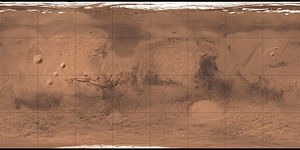Arcadia Planitia
| Great Plain on Mars | ||
|---|---|---|
| Arcadia Planitia | ||

|
||
|
|
||
| position | 49 ° N , 172 ° W | |
| expansion | 2245 km | |
Arcadia Planitia is a lowland plain on the planet Mars .
Areography
location
The flat plain is in the planet's northern hemisphere , centered at latitude 49.02 ° north and longitude 188.15 ° east. The West is in Cebrenia - the East in Diacria - degree field . In the north it borders on the north polar plain Vastitas Borealis , in the east on the Tharsis region , in the south on the Amazonis Planitia , in the south-west on the Elysium Planitia and in the west it separates the Phlegra Montes from the Utopia Planitia .
Surface structures
Lava flows
The plain was formed about 2.9 billion years ago, at the beginning of the Amazonian Age , the youngest in the geological history of Mars. During this time, large streams of lava flowed into the area from the younger volcanoes of the Tharsis and the Elysium regions , forming the current plain.
Flat landscapes
In the period that followed, however, there were only a few volcanic eruptions, the number of asteroid impacts fell sharply, atmospheric pressure fell, and the ever lower temperatures meant that liquid water could hardly survive on the surface. As a result, there were no more major geological changes and the surface is largely flat today.
Water ice
In large parts of the plain, water ice is less than a meter below the surface. Could the NASA end of 2019 for the first time using data from the Mars Reconnaissance Orbiter 's and the Mars Odyssey orbiter 's evidence. Since the subterranean water ice changes the surface temperature slightly, it could be detected with the help of the heat-sensitive measuring devices of the probes.
Manned missions
The plane is being considered by NASA and SpaceX , among others, for future manned Mars missions . On the one hand, the deep location of the plain offers better protection against the radiation exposure of the sun , which is a health hazard for the astronauts. On the other hand, the water ice that is directly below the surface can be used to prepare drinking water. In addition, the flat landscape is a relatively safe landing place.
Origin of name
The region was named after the astronomer Giovanni Schiaparelli in 1882 , who named it after Arcadia , an ancient Greek landscape. The name was officially adopted by the International Astronomical Union in 1972 .
Individual evidence
- ↑ a b Planetary Names: Planitia, planitiae: Arcadia Planitia on Mars. Retrieved June 30, 2020 .
- ↑ Star Stories, Volume 173: The Geological History of Mars. March 18, 2016, accessed June 30, 2020 (German).
- ↑ a b NASA's Treasure Map for Water Ice on Mars. Retrieved June 30, 2020 .
